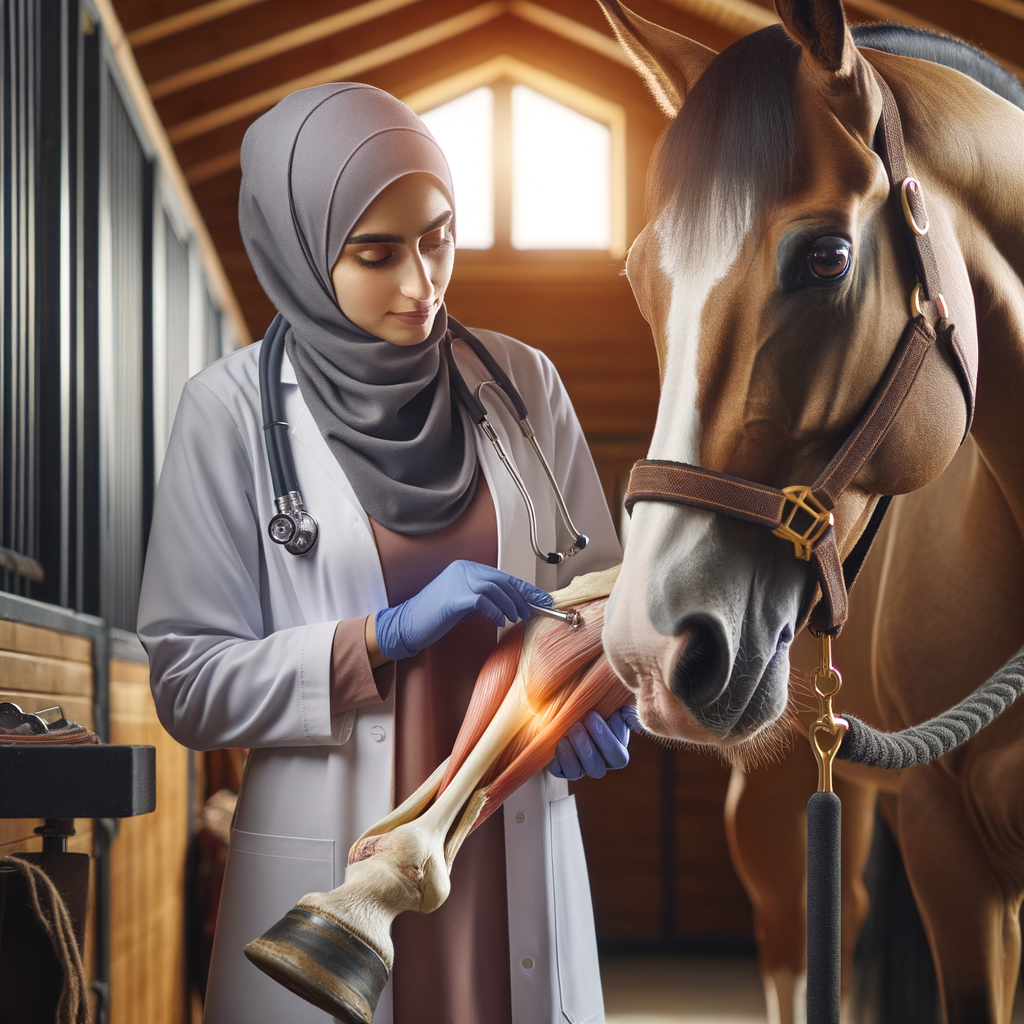
Introduction to Quarter Horse Tendon Care
-
- Understanding the importance of tendon health for Quarter Horses
Tendon health is crucial for Quarter Horses. These horses are known for their speed and agility, especially in activities like racing and rodeo events. Healthy tendons help them perform at their best and prevent injuries.
-
- Basic anatomy of a Quarter Horse’s tendon
A tendon is a tough band of fibrous tissue that connects muscle to bone. In Quarter Horses, tendons are vital for movement. They act like springs, storing and releasing energy with each step. Key tendons include the superficial digital flexor tendon and the deep digital flexor tendon.
Common Quarter Horse Tendon Injuries
Types of Injuries
Quarter Horses are known for their speed and agility. However, their active lifestyle can sometimes lead to tendon injuries. Here are some common types of tendon injuries that Quarter Horses may experience:
- Tendinitis: This is the inflammation of a tendon. It can cause pain and swelling, making it hard for the horse to move comfortably. Tendinitis often occurs from overuse or sudden injury.
- Strains and sprains: These injuries happen when tendons are stretched too far or twisted. Strains and sprains can vary in severity, from mild discomfort to serious damage that needs medical attention.
- Tendon tears: A tear in the tendon is a serious injury that can take a long time to heal. It can be partial or complete, and it usually requires rest and sometimes surgery to repair.
Understanding these injuries is the first step in keeping your Quarter Horse healthy and active. Proper care and attention can help prevent these common tendon problems.
Causes and Prevention
-
Understanding the Causes of Tendon Injuries
One common cause is overuse. When horses work too hard, their tendons can get tired and hurt. Another cause is poor footing. If the ground is too hard or too soft, it can stress the tendons. Also, bad shoeing can lead to tendon injuries. If the horse’s shoes don’t fit right, it can cause problems.
Here are some key causes:
- Overuse: Too much work without enough rest.
- Poor Footing: Uneven or slippery ground.
- Improper Shoeing: Shoes that don’t fit well.
Understanding these causes can help prevent injuries. Knowing what to look for can keep your horse healthy and happy.
-
Best Practices for Quarter Horse Tendon Injury Prevention
- Proper Training: Train your horse slowly and steadily. Don’t rush.
- Good Footing: Make sure the ground is even and safe.
- Regular Check-ups: Have a vet check your horse’s tendons often.
- Proper Shoeing: Ensure the horse’s shoes fit well.
Following these tips can help keep your horse’s tendons strong and healthy. Prevention is better than cure.
Best Practice Why It’s Important Proper Training Prevents overuse and builds strength. Good Footing Reduces stress on tendons. Regular Check-ups Catches problems early. Proper Shoeing Ensures even weight distribution.
Maintaining Quarter Horse Tendon Health
Exercise and Training
- The role of exercise in maintaining tendon health: Exercise helps improve blood flow to the tendons, which is essential for delivering nutrients and oxygen. This process aids in the repair and maintenance of tendon tissues. Additionally, consistent exercise helps in building the strength and flexibility of tendons, reducing the risk of strains and tears.
-
Quarter Horse tendon strengthening exercises:
- Walking and Trotting: These basic exercises are great for warming up and gently strengthening tendons. Start with short sessions and gradually increase the duration.
- Hill Work: Walking or trotting up gentle slopes can help build tendon strength. Ensure the slope is not too steep to avoid overexertion.
- Pole Work: Using ground poles can improve coordination and tendon strength. Start with poles on the ground and progress to raised poles as your horse gets stronger.
- Controlled Cantering: Short, controlled cantering sessions can help strengthen tendons without overloading them. Always ensure your horse is properly warmed up before cantering.
| Exercise | Benefits |
|---|---|
| Walking and Trotting | Improves blood flow, gentle strengthening |
| Hill Work | Builds strength, enhances flexibility |
| Pole Work | Improves coordination, tendon strength |
| Controlled Cantering | Strengthens tendons, reduces injury risk |
Incorporating these exercises into your Quarter Horse’s routine can significantly contribute to maintaining healthy tendons. Always consult with a veterinarian or an equine specialist before starting any new exercise regimen.
Nutrition and Supplements
-
Importance of Nutrition in Tendon Health
Just like humans, horses need a balanced diet to support their overall health. Tendons are made of collagen, a type of protein. Therefore, a diet rich in protein helps maintain tendon strength.
Vitamins and minerals also play a crucial role. For example, Vitamin C is essential for collagen production. Without enough Vitamin C, tendons can become weak. Additionally, minerals like zinc and copper are important for tendon repair and maintenance.
Feeding your horse high-quality hay and grains can provide these necessary nutrients. Always ensure your horse has access to clean water and a salt block to meet their mineral needs.
-
Recommended Supplements for Quarter Horse Tendon Support
Sometimes, a regular diet may not provide all the nutrients needed for optimal tendon health. In such cases, supplements can be beneficial. Here are some recommended supplements for Quarter Horse tendon support:
Supplement Benefit Glucosamine Supports joint and tendon health by promoting collagen production. Chondroitin Works with glucosamine to maintain tendon elasticity and strength. MSM (Methylsulfonylmethane) Reduces inflammation and supports tendon repair. Omega-3 Fatty Acids Helps reduce inflammation and supports overall tendon health. Vitamin E Acts as an antioxidant to protect tendon cells from damage. Always consult with your veterinarian before adding any supplements to your horse’s diet. They can help you choose the best options based on your horse’s specific needs.
Tips for Healthy Quarter Horse Tendons
- Regular vet check-ups: It’s important to schedule regular visits with your veterinarian. They can spot early signs of tendon issues and provide treatments before problems get worse. According to experts, early detection can prevent serious injuries.
- Proper hoof care: Good hoof care is essential for tendon health. Make sure your horse’s hooves are trimmed and balanced. Poor hoof care can lead to uneven stress on tendons, which can cause injuries. A farrier can help maintain proper hoof health.
- Appropriate rest and recovery periods: Horses need time to rest and recover, especially after intense activities. Allowing your horse to rest helps tendons heal and prevents overuse injuries. Plan rest days and avoid overworking your horse.
Quarter Horse Tendon Recovery
Rehabilitation Exercises
Recovering from a tendon injury is crucial for a Quarter Horse’s health. Proper rehabilitation exercises can help ensure a full recovery and prevent future injuries.
- Stretching and Flexibility Exercises: These exercises help improve the range of motion in the injured tendon. Gentle stretching can prevent stiffness and promote healing. For example, you can perform passive stretches by gently moving the horse’s leg in different directions.
- Low-Impact Exercises: Low-impact activities are essential during the recovery phase. These exercises include walking on soft surfaces and swimming. They help maintain muscle strength without putting too much strain on the healing tendon.
Incorporating these exercises into your horse’s recovery plan can make a significant difference. Always consult with a veterinarian or a professional equine therapist to tailor the exercises to your horse’s specific needs.
Post-Injury Care
- Importance of Rest in RecoveryWhen a tendon is injured, it needs time to heal. Rest helps reduce inflammation and prevents further damage. According to experts, a horse should rest for at least six weeks after a tendon injury.
During this time, it is important to limit the horse’s movement. Keeping the horse in a stall or a small paddock can help. This controlled environment ensures the horse does not strain the injured tendon.
- Physical Therapy Options for Quarter HorsesPhysical therapy can speed up recovery and improve tendon strength. There are several options available:
- Cold Therapy: Applying ice packs can reduce swelling and pain.
- Heat Therapy: Heat can increase blood flow and promote healing.
- Massage: Gentle massage can improve circulation and reduce stiffness.
Working with a veterinarian or a professional therapist is important. They can create a customized plan for your horse. This plan may include specific exercises and treatments to aid recovery.
| Therapy Option | Benefits |
|---|---|
| Cold Therapy | Reduces swelling and pain |
| Heat Therapy | Increases blood flow, promotes healing |
| Massage | Improves circulation, reduces stiffness |
Case Studies: Quarter Horse Tendon Wellness Success Stories
-
Case Study 1: Recovery from a Severe Tendon Tear
Meet “Thunder,” a 7-year-old Quarter Horse who suffered a severe tendon tear during a competition. The injury was serious and required immediate attention.
Initial Treatment: Thunder’s vet recommended a combination of rest, anti-inflammatory medications, and cold therapy. The first few weeks were critical for reducing swelling and pain.
Rehabilitation: After the initial recovery phase, Thunder began a controlled exercise program. This included light walking and gradual increases in activity to strengthen the tendon without overloading it.
Outcome: After six months of dedicated care, Thunder made a full recovery. He returned to competition and performed exceptionally well, showing no signs of his previous injury.
-
Case Study 2: Successful Management of Chronic Tendinitis
“Bella,” a 10-year-old Quarter Horse, had been struggling with chronic tendinitis for years. This condition caused her persistent pain and limited her ability to perform.
Initial Diagnosis: Bella’s vet used ultrasound imaging to diagnose the extent of her tendinitis. This helped in creating a targeted treatment plan.
Treatment Plan: Bella’s treatment included shockwave therapy, which promotes healing by stimulating blood flow. She also received regular massages and stretching exercises to maintain flexibility.
Management: To prevent flare-ups, Bella’s exercise routine was carefully monitored. Her diet was also adjusted to include supplements that support tendon health.
Outcome: With consistent care, Bella’s tendinitis was successfully managed. She experienced fewer flare-ups and was able to enjoy a more active and pain-free life.
Conclusion: Best Practices for Quarter Horse Tendons
-
Key takeaways for maintaining tendon health:
- Regular Check-ups: Schedule routine vet visits to catch issues early.
- Proper Warm-up: Always warm up your horse before intense activities.
- Balanced Diet: Ensure your horse gets the right nutrients for strong tendons.
- Controlled Exercise: Avoid overworking your horse to prevent strain.
-
Final tips and tricks for Quarter Horse tendon care:
- Use Supportive Gear: Consider using tendon boots during training.
- Monitor Surfaces: Train on even, soft ground to reduce impact.
- Hydration: Keep your horse well-hydrated to maintain tissue health.
- Rest Periods: Allow ample rest between training sessions.
| Best Practice | Benefit |
|---|---|
| Regular Check-ups | Early detection of tendon issues |
| Proper Warm-up | Prevents sudden strain on tendons |
| Balanced Diet | Strengthens tendons and overall health |
| Controlled Exercise | Reduces risk of overuse injuries |
| Supportive Gear | Provides extra protection during activities |
| Monitor Surfaces | Minimizes impact on tendons |
| Hydration | Keeps tendons flexible and healthy |
| Rest Periods | Allows tendons to recover |
By following these best practices, you can help ensure your Quarter Horse’s tendons stay healthy and strong. A little extra care goes a long way in preventing injuries and promoting overall wellness.









